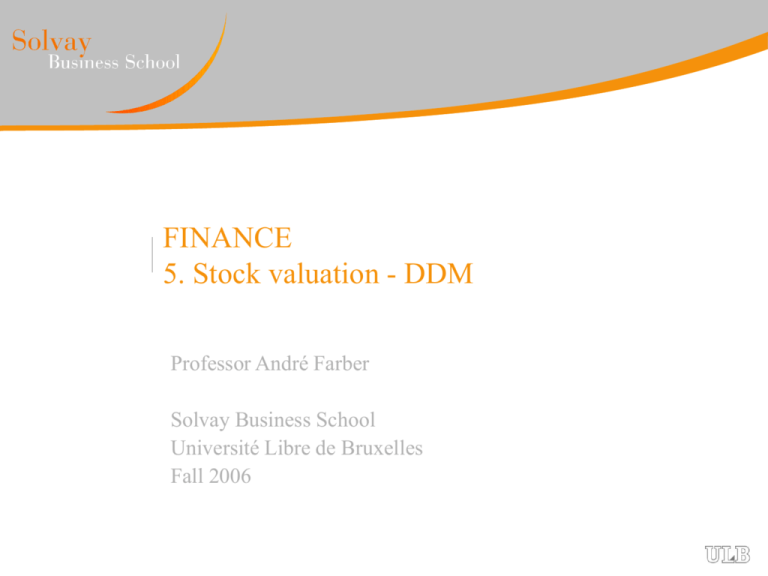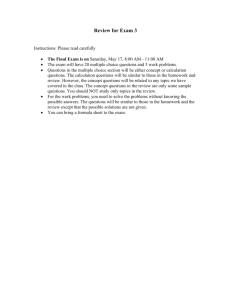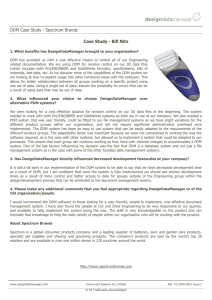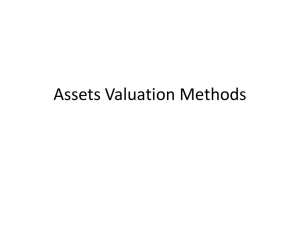MBA Finance - de l'Université libre de Bruxelles
advertisement

FINANCE 5. Stock valuation - DDM Professor André Farber Solvay Business School Université Libre de Bruxelles Fall 2006 Stock Valuation • 1. 2. 3. 4. 5. Objectives for this session : Introduce the dividend discount model (DDM) Understand the sources of dividend growth Analyse growth opportunities Examine why Price-Earnings ratios vary across firms Introduce free cash flow model (FCFM) MBA 2006 DDM |2 DDM: one-year holding period • Review: valuing a 1-year 4% coupon bond • Face value: € 50 Bond price P0 = (50+2)/1.05 = 49.52 • Coupon: €2 • Interest rate 5% • How much would you be ready to pay for a stock with the following characteristics: • Expected dividend next year: € 2 • Expected price next year: €50 Looks like the previous problem. But one crucial difference: – Next year dividend and next year price are expectations, the realized price might be very different. Buying the stock involves some risk. The discount rate should be higher. • MBA 2006 DDM |3 Dividend Discount Model (DDM): 1-year horizon • 1-year valuation formula Expected price div1 P1 P0 1 r r = expected return on shareholders'equity = Risk-free interest rate + risk premium • Back to example. Assume r = 10% 2 50 P0 47.27 1 0.10 Dividend yield = 2/47.27 = 4.23% Rate of capital gain = (50 – 47.27)/47.27 = 5.77% MBA 2006 DDM |4 DDM: where does the expected stock price come from? • Expected price at forecasting horizon depends on expected dividends and expected prices beyond forecasting horizon • To find P2, use 1-year valuation formula again: • Current price can be expressed as: P0 P1 div 2 P2 1 r div1 div 2 P2 1 r (1 r ) 2 (1 r ) 2 • General formula: div1 div 2 divT PT P0 ... 2 T 1 r (1 r ) (1 r ) (1 r ) T MBA 2006 DDM |5 DDM - general formula • With infinite forecasting horizon: P0 div3 divt div1 div2 ... ... (1 r ) (1 r ) 2 (1 r ) 3 (1 r ) t • Forecasting dividends up to infinity is not an easy task. So, in practice, simplified versions of this general formula are used. One widely used formula is the Gordon Growth Model base on the assumption that dividends grow at a constant rate. • DDM with constant growth g div1 P0 rg • Note: g < r MBA 2006 DDM |6 DDM with constant growth : example Data Next dividend: 6.00 Div.growth rate: 4% Discount rate: 10% Year Dividend DiscFac 0 Price 100.00 1 6.00 0.9091 104.00 2 6.24 0.8264 108.16 3 6.49 0.7513 112.49 4 6.75 0.6830 116.99 5 7.02 0.6209 121.67 6 7.30 0.5645 126.53 7 7.59 0.5132 131.59 8 7.90 0.4665 136.86 9 8.21 0.4241 142.33 10 8.54 0.3855 148.02 MBA 2006 DDM P0= 6/(.10-.04) |7 Differential growth • Suppose that r = 10% • You have the following data: Year 1 2 3 4 to ∞ Dividend 2 2.40 2.88 3.02 20% 20% 5% Growth rate • P3 = 3.02 / (0.10 – 0.05) = 60.48 P0 2 2.40 2.88 60.48 51.40 2 3 3 1.10 (1.10) (1.10) (1.10) MBA 2006 DDM |8 A formula for g • Dividend are paid out of earnings: • Dividend = Earnings × Payout ratio • Payout ratios of dividend paying companies tend to be stable. • Growth rate of dividend g = Growth rate of earnings • Earnings increase because companies invest. • Net investment = Retained earnings • Growth rate of earnings is a function of: • Retention ratio = 1 – Payout ratio • Return on Retained Earnings g = (Return on Retained Earnings) × (Retention Ratio) MBA 2006 DDM |9 Example • Data: • Expected earnings per share year 1: EPS1 = €10 • Payout ratio : 60% • Required rate of return r : 10% • Return on Retained Earnings RORE: 15% • Valuation: • Expected dividend per share next year: div1 = 10 × 60% = €6 • Retention Ratio = 1 – 60% = 40% • Growth rate of dividend g = (40%) × (15%) = 6% • Current stock price: • P0 = €6 / (0.10 – 0.06) = €150 MBA 2006 DDM |10 Return on Retained Earnings and Debt • Net investment = Total Asset • For a levered firm: • Total Asset = Stockholders’ equity + Debt • RORE is a function of: • Return on net investment (RONI) • Leverage (L = D/ SE) RORE = RONI + [RONI – i (1-TC)]×L MBA 2006 DDM |11 Growth model: example Dep/TotAsset TaxRate Year Payout RORE 10% 40% 0 Depreciation Net Income Dividend Cfop Cfinv Cffin Change in cash Total Assets Book Equity 1,000.00 1,000.00 1 60% 25% 2 60% 20% 3 4 to infinity 60% 100% 15% 15% 100.00 400.00 240.00 116.00 440.00 264.00 133.60 475.20 285.12 152.61 503.71 503.71 500.00 -260.00 -240.00 0.00 556.00 -292.00 -264.00 0.00 608.80 -323.68 -285.12 0.00 656.32 -152.61 -503.71 0.00 1,160.00 1,160.00 1,336.00 1,336.00 1,526.08 1,526.08 1,526.08 1,526.08 MBA 2006 DDM |12 Valuing the company • Assume discount rate r = 15% • Step 1: calculate terminal value • As Earnings = Dividend from year 4 on • V3 = 503.71/15% = 3,358 • Step 2: discount expected dividends and terminal value V0 240 264 285.12 3,358.08 2,803.78 3 1.15 (1.15) 2 (1.15) 3 (1.15) MBA 2006 DDM |13 Valuing Growth Opportunities • Consider the data: • Expected earnings per share next year EPS1 = €10 • Required rate of return r = 10% Cy A Cy B Cy C Payout ratio 60% 60% 100% Return on Retained Earnings 15% 10% - Next year’s dividend €6 €6 €10 g 6% 4% 0% €150 €100 €100 Price per share P0 • Why is A more valuable than B or C? • Why do B and C have same value in spite of different investment policies MBA 2006 DDM |14 NPVGO • Cy C is a “cash cow” company • Earnings = Dividend (Payout = 1) • No net investment • Cy B does not create value • Dividend < Earnings, Payout <1, Net investment >0 • But: Return on Retained Earnings = Cost of capital • NPV of net investment = 0 • Cy A is a growth stock • Return on Retained Earnings > Cost of capital • Net investment creates value (NPV>0) • Net Present Value of Growth Opportunities (NPVGO) • NPVGO = P0 – EPS1/r = 150 – 100 = 50 MBA 2006 DDM |15 Source of NPVG0 ? • Additional value if the firm retains earnings in order to fund new projects P0 EPS PV ( NPV1 ) PV ( NPV2 ) PV ( NPV3 ) ... r • where PV(NPVt) represent the present value at time 0 of the net present value (calculated at time t) of a future investment at time t • In previous example: Year 1: EPS1 = 10 div1 = 6 Net investment = 4 EPS = 4 * 15% = 0.60 (a permanent increase) NPV1 = -4 + 0.60/0.10 = +2 (in year 1) PV(NPV1) = 2/1.10 = 1.82 MBA 2006 DDM |16 NPVGO: details P0 PV g = 0 NPVGO Year 1 2 3 4 5 6 7 8 9 10 11 12 13 14 15 16 17 18 19 20 150.00 100.00 50.00 EPS1 10.00 10.00 10.00 10.00 10.00 10.00 10.00 10.00 10.00 10.00 10.00 10.00 10.00 10.00 10.00 10.00 10.00 10.00 10.00 10.00 Y1 to Y25 Y26 to 50 Y51 to 75 Y76 to 100 EPSt 10.00 10.60 11.24 11.91 12.62 13.38 14.19 15.04 15.94 16.89 17.91 18.98 20.12 21.33 22.61 23.97 25.40 26.93 28.54 30.26 Net Inv. 4.00 4.24 4.49 4.76 5.05 5.35 5.67 6.01 6.38 6.76 7.16 7.59 8.05 8.53 9.04 9.59 10.16 10.77 11.42 12.10 30.19 11.96 4.74 1.88 EPS 0.60 0.64 0.67 0.71 0.76 0.80 0.85 0.90 0.96 1.01 1.07 1.14 1.21 1.28 1.36 1.44 1.52 1.62 1.71 1.82 NPV 2.00 2.12 2.25 2.38 2.52 2.68 2.84 3.01 3.19 3.38 3.58 3.80 4.02 4.27 4.52 4.79 5.08 5.39 5.71 6.05 PV(NPV) 1.82 1.75 1.69 1.63 1.57 1.51 1.46 1.40 1.35 1.30 1.26 1.21 1.17 1.12 1.08 1.04 1.01 0.97 0.93 0.90 MBA 2006 DDM |17 What Do Price-Earnings Ratios mean? • Definition: P/E = Stock price / Earnings per share 1 NPVGO • Why do P/E vary across firms? P/E r EPS • As: P0 = EPS/r + NPVGO • Three factors explain P/E ratios: • Accounting methods: – Accounting conventions vary across countries • The expected return on shareholders’equity – Risky companies should have low P/E • Growth opportunities MBA 2006 DDM |18 Beyond DDM: The Free Cash Flow Model • Consider an all equity firm. • If the company: – Does not use external financing (not stock issue, # shares constant) – Does not accumulate cash (no change in cash) • Then, from the cash flow statement: » Free cash flow = Dividend » CF from operation – Investment = Dividend – Company financially constrained by CF from operation • If external financing is a possibility: » Free cash flow = Dividend – Stock Issue • Market value of company = PV(Free Cash Flows) MBA 2006 DDM |19






